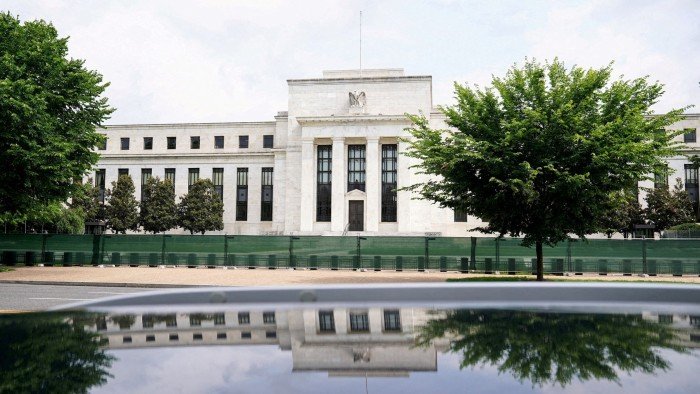Hello from FT towers in London — I’m Joel Suss, standing in for Chris Giles.
Another week, another threat to oust Jay Powell. Markets seem unperturbed, with muted reaction to reports on Friday and over the weekend that President Donald Trump was again looking into firing the Federal Reserve chair, this time because of refurbishment cost overruns at the central bank.
Markets also largely brushed off the White House’s multiple, oddly phrased tariff letters. Reprinting the infamous “liberation day” tariff board perhaps presented too high fixed menu costs.
Is this just the latest roughhousing of Powell and US trade partners, or will the muted reaction be taken as a green light? Send me your thoughts at joel.suss@ft.com.
Pressure cooker
On Friday Russell Vought, director of the US Office of Management and Budget, sent a letter to Powell saying he had “grossly mismanaged the Fed” owing to the “ostentatious” renovations of the central bank’s Washington headquarters.
This was widely seen as a new front on which to attack Powell and pretext to fire him “for cause”. The Fed has responded with an FAQ page on the refurbishments in an attempt to counter some of the accusations.
Powell has said he would bring a legal challenge against any attempt to oust him, and firing “for cause” is not a straightforward endeavour.
Regardless, the Kevins — Warsh and Hassett, who are seen as having the greatest chances of being named next Fed chair — pounced over the weekend.
Kevin Hassett, Trump’s adviser and current director of the National Economic Council, gave an interview with CNBC on Sunday in which he said firing Powell was “being looked into” and praised the US president as “one of the most successful, if not the most successful businessmen in the 20th century”.
(Hassett also said the “consumer price inflation index . . . is the lowest it’s been in over a decade”, an easily disproved assertion that in simpler times might have been a disqualifier for the role.)
Kevin Warsh, former Fed governor, told Fox News it was time for “regime change” at the central bank, with the problem going far beyond Powell. (“A whole range of people . . . it’s about breaking some heads.”) He added that when long-dated Treasury yields went up after the Fed cut by a percentage point last year, it was because the institution was “losing credibility”.
Trump’s primary stated concern about higher rates is that it is leading to higher bond yields. But the correlation between the fed funds rate and long-dated yields has long since broken down. Alan Greenspan puzzled over what he termed “the conundrum” back in 2005, when rising rates in the lead-up to the financial crisis did not move long-term yields.
Researchers at the St Louis Fed found that a similar breakdown in the relationship occurred elsewhere following the introduction of a policy rate instrument, with the correlation between the Bank of England’s interest rate and 10-year gilts having disappeared in 1992 (when the central bank first began to have scheduled monetary policy meetings).
Warsh should understand this. That he is saying otherwise on TV demonstrates he is communicating to an audience of one, at the risk of his credibility.
Communication breakdown
Last week’s newsletter was about the importance of the messenger — who communicates monetary policy matters. The French pay more attention to European Central Bank pronouncements when they are given by Christine Lagarde, a French woman, than from previous non-French ECB chiefs. Trump’s ceaseless attacks and politicisation of Powell will probably reduce trust in the Fed, degrading the messenger and with it the Fed’s message.
But when it comes to monetary policy communication, audience also matters.
Until fairly recently, central banks used not to bother communicating at all. (The Fed only began announcing its interest rate decision in 1994.) But when they did, it was largely for a specific and specialised audience of market participants and economists.
The recent revolution has been about speaking also to the public. Communications is now widely recognised as an important policy tool for anchoring inflation expectations.
But the public still does not appear to be getting the message (never mind the US president).
A recent working paper shows Fed speeches have a “Delphic effect” — when rate-setters warn about rising inflation to come, households believe the prophecy and revise their expectations higher. However, unlike professional forecasters, households don’t hear the “Odyssean” promise that typically comes alongside the warning — that in the face of rising inflation, the Fed will tie itself to the mast and raise interest rates.
In the current environment, where Fed policymakers have repeatedly warned of looming tariff-induced inflation and voiced concern that expectations can become unanchored, the communication may become self-fulfilling, Oedipus-style.
What I’ve been reading and watching
A chart that matters
What this humble bar chart shows is pretty neat: a model based on FT journalism performs better than a standard benchmark and the Fed in predicting US inflation.
The FT models include monthly average sentiment from FT articles, which we’ve termed the “macro mood index”, as well as a breakdown of topic coverage.
Check out the full article over at the FT’s Monetary Policy Radar, part of a series of posts exploring alternative data and the FT’s own archive for central bank insights.
Last week’s newsletter was amended to correct an omission in a chart


